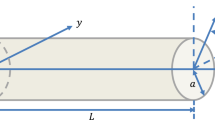Abstract
An almost exact solution is derived for the forced vibration of a composite beam with periodically varying non-smooth interface through a moderate weak-form formulation. The material property of a non-uniform beam is characterized by its flexural rigidity function R(x). In the novel method, R(x) is relaxed to be an integrable function rather than a \({\mathcal{C}}^2\) smooth function in the usual approach. The R(x)-orthogonal bases in the linear span of all boundary functions are derived such that the second-order derivatives of the bases elements are orthogonal with respect to the weight function R(x). When the deflection of the beam is expressed in terms of the bases, the expansion coefficients can be determined exactly in closed form owing to the R(x)-orthogonality of the bases. The solution obtained is almost exact, since its accuracy can be up to the order \(10^{-15}\). This powerful method is used to analyze the forced vibration behavior of composite beams with three different periodic interfaces.




Similar content being viewed by others
References
Abu-Hilal, M.: Forced vibration of Euler–Bernoulli beams by means of dynamic Green functions. J. Sound Vib. 267, 191–207 (2003)
Balduzzi, G., Aminbaghai, M., Auricchio, F., Fussl, J.: Planar Timoshenko-like model for multilayer non-prismatic beams. Int. J. Mech. Mater. Des. 14, 51–70 (2018)
Banerjee, J.R., Su, H., Jackson, D.R.: Free vibration of rotating tapered beams using the dynamic stiffness method. J. Sound Vib. 298, 1034–1054 (2006)
Bruant, I., Proslier, L.: Optimal location of piezoelectric actuators for active vibration control of thin axially functionally graded beams. Int. J. Mech. Mater. Des. 12, 173–192 (2016)
Datta, A.K., Sil, S.N.: An analytical of free undamped vibration of beams of varying cross-section. Comput. Struct. 59, 479–483 (1996)
Dong, X.Y., Bai, Z.B., Zhang, S.Q.: Positive solutions to boundary value problems of p-Laplacian with fractional derivative. Bound. Value Probl. 5, 1–15 (2017)
Huang, Y., Li, X.F.: A new approach for free vibration of axially functionally graded beams with non-uniform cross-section. J. Sound Vib. 329, 2291303 (2010)
Li, F.S.: Global existence and uniqueness of weak solution for nonlinear viscoelastic full Marguerre–von Karman shallow shell equations. Acta Math. Sin. 25, 2133–2156 (2009)
Li, H., Balachandran, B.: Buckling and free oscillations of composite microresonators. J. Micromech. Syst. 15, 42–51 (2006)
Li, B., Liu, C.-S.: A new method for the deflection analysis of composite beams with periodically varying interfaces. Z. Angew. Math. Mech. 98, 718–726 (2018)
Li, B., Dong, L., Zhu, L., Chen, X.: On the natural frequency and vibration mode of composite beam with non-uniform cross-section. J. Vibroeng. 17, 2491–2502 (2015)
Li, B., Liu, C.-S., Zhu, L.: Vibration analysis of composite beams with sinusoidal periodically varying interfaces. Z. Nat. A 73, 57–67 (2018a)
Li, B., Liu, C.-S., Zhu, L.: A general algorithm on the natural vibration analysis of composite beams with arbitrary complex interfaces. Z. Nat. A 73, 995–1004 (2018b)
Liu, C.-S., Li, B.: A fast new algorithm for solving a nonlinear beam equation under nonlinear boundary conditions. Z. Nat. A 72, 397–400 (2017a)
Liu, C.-S., Li, B.: An upper bound theory to approximate the natural frequencies and parameters identification of composite beams. Compos. Struct. 171, 131–144 (2017b)
Myint-U, T., Debnath, L.: Partial Differential Equations for Scientists and Engineers, 3rd edn. Prentice-Hall, Englewood Cliffs (2007)
Raja, S., Venkata, R.K., Gowda, M.T.: Improved finite element modeling of piezoelectric beam with edge debonded actuator for actuation authority and vibration behaviour. Int. J. Mech. Mater. Des. 13, 25–41 (2017)
Sahoo, S.R., Ray, M.C.: Analysis of smart damping of laminated composite beams using mesh free method. Int. J. Mech. Mater. Des. 14, 359–374 (2018)
Sears, A., Batra, R.: Macroscopic properties of carbon nanotubes from molecular-mechanics simulations. Phys. Rev. B 69, 235406 (2004)
Shaat, M., Abdelkefi, A.: Buckling characteristics of nanocrystalline nano-beams. Int. J. Mech. Mater. Des. 14, 71–89 (2018)
Author information
Authors and Affiliations
Corresponding author
Appendices
Appendix 1
In this appendix we derive Eq. (11). Multiplying Eq. (3) by \(\phi (x)\) and integrating the resultant from \(x=0\) to \(x=L\), yield
Integrating the integral term in the left-hand side by parts two times and using Eqs. (8) and (12), we have
Inserting it into Eq. (24) we can derive Eq. (11) for the simple beam equation.
For the clamped–clamped beam we have
Inserting it into Eq. (24) we can derive Eq. (11) for the clamped–clamped beam equation.
Similarly, for the cantilevered beam we have
Inserting it into Eq. (24) we can derive Eq. (11) for the cantilevered beam equation.
Appendix 2
In this appendix we derive Eqs. (15)–(17). Let
be a boundary function for the simple beam, where a and b are to be determined such that \(B_j(x)\) satisfies all the boundary conditions in Eq. (8). It is obvious that \(B_j(x)\) satisfies \(B_j(0)=0\) and \(B_j''(0)=0\) due to \(j\ge 2\). To satisfy \(B_j(L)=0\) and \(B_j''(L)=0\) we can derive
which can be solved to
Inserting a and b into Eq. (28) we can derive Eq. (15).
Let
be a boundary function for the clamped–clamped beam. It is obvious that \(B_j(x)\) satisfies \(B_j(0)=0\) and \(B_j'(0)=0\) due to \(j\ge 1\). To satisfy \(B_j(L)=0\) and \(B_j'(L)=0\) we can derive
which can be solved to
Inserting a and b into Eq. (32) we can derive Eq. (16).
Finally, let
be a boundary function for the cantilevered beam. It is obvious that \(B_j(x)\) satisfies \(B_j(0)=0\) and \(B_j'(0)=0\) due to \(j\ge 1\). To satisfy \(B_j''(L)=0\) and \(B_j'''(L)=0\) we can derive
which can be solved to
Rights and permissions
About this article
Cite this article
Liu, CS., Li, B. & Kuo, CL. Novel method for analyzing the behavior of composite beams with non-smooth interfaces. Int J Mech Mater Des 15, 671–679 (2019). https://doi.org/10.1007/s10999-018-09436-8
Received:
Accepted:
Published:
Issue Date:
DOI: https://doi.org/10.1007/s10999-018-09436-8




